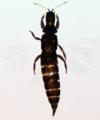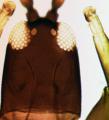Leptothrips distalis
Recognition data
Distinguishing features
Both sexes fully winged. Body brown with reddish purple internal pigment; legs brown, fore tarsi and apices of fore tibiae yellow; antennal segment III largely yellow, IV–VI yellow at base; major setae light brown; fore wings pale, scarcely shaded at base. Head distinctly longer than wide; maxillary stylets retracted to eyes, about one third of head width apart medially; eyes not prolonged ventrally; postocular setae weakly capitate, shorter than eye length. Antennae 8-segmented; segment III with one sensorium, IV with four sensoria, VIII short and broad at base. Pronotum with 5 pairs of weakly capitate major setae; prosternal basantra and ferna well developed, mesopresternum reduced to paired lateral triangles although these are sometimes joined medially. Fore tarsus with small pointed tooth. Metanotum closely striate medially. Fore wing constricted medially, with about 10 duplicated cilia; sub-basal seta S3 pointed and much longer than capitate S1 and S2. Tergite IX setae S1 acute, about as long as tube.
Male similar to female, but fore tarsal tooth larger; tergite IX setae S2 short and stout; sternite VIII with no pore plate; pseudovirga of aedeagus slender.
Related and similar species
The genus Leptothrips is related to Haplothrips, but the metanotal sculpture is closely striate not reticulate, and larvae and adults usually have extensive purple internal pigment. In total, 38 species are listed under Leptothrips, all from the Americas. Johansen (1987), in describing 22 of these as new species, recorded 11 Leptothrips from California, although only seven were listed by Hoddle et al. (2004). The validity of some of the species in the genus remains questionable, as discussed here under L. mali. The problem is that many of these species were differentiated on character states that are very difficult to observe on their type specimens because these are poor quality slide-mounts. Moreover, there is little recorded habitat segregation between several of the nominal species, given that they are all considered to be predators of other arthropods.
Taxonomic data
Current valid name
Leptothrips distalis (Hood)
Original name and synonyms
- Haplothrips distalis Hood, 1925: 103
- Zygothrips californicus Mason, 1927: 156
Family placement
Phlaeothripidae, Phlaeothripinae
Biological data
Life history
Presumably predatory on small arthropods.
Host plants
Adults taken from various desert shrubs, particularly Atriplex (Chenopodiaceae).
Tospoviruses vectored
None
Crop damage
None
Distribution data
Area of origin
Western USA.
Distribution
Nevada, North Dakota, California, Montana, Utah, New Mexico








